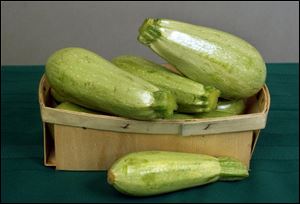
Tasty stuffed squash was worth the wait
8/12/2003I've been waiting all summer to buy the small light green squash known as koosa. After tasting the squash filled with beef or lamb and rice and then cooked by Karyn Hajjar last season, I knew I wanted to make it myself.
Koosa is sold at Middle Eastern markets and farmers' markets. I bought a little basket filled with koosa from Betty Jeffers' stand at the Toledo Farmers' Market. Jeffers Farms and growers like Donna Puehler of Puehler Farms in Delta have been growing koosa for the area this summer after produce farmer Harold A. Loeffler died in June. He was known as the “koosa man” because he grew this type of squash for 25 years and even delivered the produce to parishioners at St. George Antiochian Orthodox Cathedral.
When preparing koosa, you must first remove the center of the squash lengthwise. For this you need a vegetable corer. Mrs. Hajjar sent me to Toledo Market, 3410 Dorr St., where I found two types ranging in price from $1.99 to $2.89. The clerk advised “the old-fashioned [$1.99] type, especially if you don't know what you're doing.” So I bought it.
Armed with Mrs. Hajjar's advice and a recipe from Helen Corey's Food from Biblical Lands (self-published, 1989), which includes pictures of coring, stuffing, and the finished product, I made the tasty dish that cooked on the stovetop in 30 minutes.
The best part: After dishing up the cooked koosa, the vegetable can be sliced crosswise, yielding perfect rings of squash filled with meat-rice mixture. I spooned tomato sauce across the fanned slices. (See recipe on Page 2.)
While Ms. Corey's recipe of uncooked rice and lamb or beef is flavored simply with garlic, salt and pepper, and mint leaves, Mrs. Hajjar's recipe adds cinnamon.

Koosa is a summer squash.
Once the core of the koosa is removed, the key is not to pack the stuffing in the squash too tightly. Since the rice is uncooked, it needs room to expand during cooking.
The stuffed koosa is cooked in tomato sauce with fresh mint and garlic until the rice is cooked and tender.
“Koosa with Laban [yogurt] is also good,” says Mrs. Hajjar. For this, she sautes garlic in butter with mint and a little flour, making a roux. Then she whisks in yogurt, making a cream sauce. Once the center is removed from the koosa, the squash is boiled and then it is cooked in the yogurt sauce.
A baby koosa can be tricky to core, she says. The small squash can be stuffed with cooked lamb, onions, pine nuts, cinnamon, and salt and pepper, and then fried until brown. Then it's baked in yogurt sauce for 15 minutes. “It's a lot of work,” she said.
There are also vegetarian koosa recipes. “Use everything you would use for tabouli, except in place of cracked wheat, use rice.”
Koosa is now much easier to buy in this country. “We used to go through this huge process every fall, stuffing and cooking koosa and then freezing it,” says Mrs. Hajjar. Some people pickled it so it would be ready for stuffed koosa. (Squash that is bought in brine needs to be rinsed in cold water, squeezed to remove moisture, then stuffed and cooked, according to Helen Corey's cookbook.)
The pulp of the koosa is saved for a type of potato pancake. It's mixed with egg, shredded potato, mint, and shredded green onion, and is fried in olive oil.